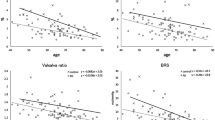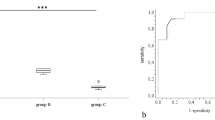Abstract
Objective
Familial dysautonomia (FD) involves incomplete development of the sympathetic nervous system. Whether such loss extends to sympathetic innervation of the heart has been unknown. This study used 6-[18F]fluorodopamine neuroimaging to assess cardiac sympathetic innervation and function in FD.
Methods
Six adult FD patients underwent thoracic PET scanning for 30 minutes after i.v. 6-[18F]fluorodopamine injection, as did healthy volunteers without (N = 21) or with (N = 10) pre-treatment by desipramine, which interferes with neuronal uptake and thereby simulates effects of noradrenergic denervation. Effective rate constants for uptake and loss were calculated using a single compartment pharmacokinetic model.
Results
FD patients had decreased uptake and accelerated loss of 6-[18F]fluorodopamine-derived radioactivity in the interventricular myocardial septum (P = 0.009, P = 0.05) and ventricular free wall (P = 0.007, P < 0.001), compared to untreated controls. Desipramine-treated subjects had decreased uptake but normal loss of 6-[18F]fluorodopamine-derived radioactivity.
Conclusions
FD involves cardiac noradrenergic hypo-innervation. Since accelerated loss of 6-[18F]fluorodopamine-derived radioactivity cannot be explained by decreased neuronal uptake alone, FD may also involve augmented NE loss from extant terminals.


Similar content being viewed by others
References
Axelrod FB (2006) A world without pain or tears. Clin Auton Res 16:90–96
Axelrod FB, Goldberg JD, Ye XY, Maayan C (2002) Survival in familial dysautonomia: impact of early intervention. J Pediatr 141:518–523
Close P, Hawkes N, Cornez I, Creppe C, Lambert CA, Rogister B, Siebenlist U, Merville MP, Slaugenhaupt SA, Bours V, Svejstrup JQ, Chariot A (2006) Transcription impairment and cell migration defects in elongator-depleted cells: implication for familial dysautonomia. Mol Cell 22:521–531
Freedman LS, Ebstein RP, Goldstein M, Axelrod FB, Dancis J (1975) Serum dopamine-beta-hydroxylase in familial dysautonomia. J Lab Clin Med 85:1008–1012
Glickstein JS, Axelrod FB, Friedman D (1999) Electrocardiographic repolarization abnormalities in familial dysautonomia: an indicator of cardiac autonomic dysfunction. Clin Auton Res 9:109–112
Gold-von Simson G, Rutkowski M, Berlin D, Axelrod FB (2005) Pacemakers in patients with familial dysautonomia–a review of experience with 20 patients. Clin Auton Res 15:15–20
Goldstein DS, Eisenhofer G, Dunn BB, Armando I, Lenders J, Grossman E, Holmes C, Kirk KL, Bacharach S, Adams R, Herscovitch P, Kopin IJ (1993) Positron emission tomographic imaging of cardiac sympathetic innervation using 6-[18F]fluorodopamine: initial findings in humans. J Am Coll Cardiol 22:1961–1971
Goldstein DS, Grossman E, Tamrat M, Chang PC, Eisenhofer G, Bacher J, Kirk KL, Bacharach S, Kopin IJ (1991) Positron emission imaging of cardiac sympathetic innervation and function using 18F-6-fluorodopamine: effects of chemical sympathectomy by 6-hydroxydopamine. J Hypertens 9:417–423
Goldstein DS, Holmes C, Li ST, Bruce S, Metman LV, Cannon RO 3rd (2000) Cardiac sympathetic denervation in Parkinson disease. Ann Intern Med 133:338–347
Goldstein DS, Holmes C, Stuhlmuller JE, Lenders JWM, Kopin IJ (1997) 6-[18F]Fluorodopamine positron emission tomographic scanning in the assessment of cardiac sympathoneural function–studies in normal humans. Clin Auton Res 7:17–29
Goldstein DS, Katzper M, Linares OA, Kopin IJ (2002) Kinetic model for the fate of the sympathoneural imaging agent 6-[18F]fluorodopamine in the human heart: a novel means to assess cardiac sympathetic neuronal function. Naunyn-Schmiedeberg’s Arch Pharmacol 365:38–49
Goodall MC, Gitlow SE, Alton H (1971) Decreased noradrenaline (norepinephrine) synthesis in familial dysautonomia. J Clin Invest 50:2734–2740
Kashihara K, Ohno M, Kawada S, Okumura Y (2006) Reduced cardiac uptake and enhanced washout of 123I-MIBG in pure autonomic failure occurs conjointly with Parkinson’s disease and dementia with Lewy bodies. J Nucl Med 47:1099–1101
Pearson J, Brandeis L, Goldstein M (1979) Tyrosine hydroxylase immunoreactivity in familial dysautonomia. Science 206:71–72
Pearson J, Dancis J, Axelrod F, Grover N (1975) The sural nerve in familial dysautonomia. J Neuropathol Exp Neurol 34:413–424
Pearson J, Gallo G, Gluck M, Axelrod F (1980) Renal disease in familial dysautonomia. Kidney Int 17:102–112
Pearson J, Pytel BA (1978) Quantitative studies of sympathetic ganglia and spinal cord intermedio-lateral gray columns in familial dysautonomia. J Neurol Sci 39:47–59
Rotstein A, Charrow J, Deal BJ (2007) Documented transient third-degree atrioventricular block and asystole in a child with familial dysautonomia. Pediatr Cardiol
Slaugenhaupt SA, Blumenfeld A, Gill SP, Leyne M, Mull J, Cuajungco MP, Liebert CB, Chadwick B, Idelson M, Reznik L, Robbins C, Makalowska I, Brownstein M, Krappmann D, Scheidereit C, Maayan C, Axelrod FB, Gusella JF (2001) Tissue-specific expression of a splicing mutation in the IKBKAP gene causes familial dysautonomia. Am J Hum Genet 68:598–605
Slaugenhaupt SA, Mull J, Leyne M, Cuajungco MP, Gill SP, Hims MM, Quintero F, Axelrod FB, Gusella JF (2004) Rescue of a human mRNA splicing defect by the plant cytokinin kinetin. Hum Mol Genet 13:429–436
Smith AA, Taylor T, Wortis B (1963) Abnormal catechol amine metabolism in familial dysautonomia. N Engl J Med 268:705–707
Taki J, Nakajima K, Hwang EH, Matsunari I, Komai K, Yoshita M, Sakajiri K, Tonami N (2000) Peripheral sympathetic dysfunction in patients with Parkinson’s disease without autonomic failure is heart selective and disease specific. Eur J Nucl Med 27:566–573
Weinshilboum RM, Axelrod J (1971) Reduced plasma dopamine-beta-hydroxylase activity in familial dysautonomia. N Engl J Med 285:938–942
Ziegler MG, Lake CR, Kopin IJ (1976) Deficient sympathetic nervous response in familial dysautonomia. N Engl J Med 294:630–633
Acknowledgments
This research was supported by the Intramural Research Program of the NIH, National Institute of Neurological Disorders and Stroke.
Author information
Authors and Affiliations
Corresponding author
Rights and permissions
About this article
Cite this article
Goldstein, D.S., Eldadah, B., Sharabi, Y. et al. Cardiac sympathetic hypo-innervation in familial dysautonomia. Clin Auton Res 18, 115–119 (2008). https://doi.org/10.1007/s10286-008-0464-1
Received:
Accepted:
Published:
Issue Date:
DOI: https://doi.org/10.1007/s10286-008-0464-1




